
| Donald Ambrose Eubank |
| Born: July 22, 1949 On This Day |
| Birth City: Kansas City, Missouri |
| Father: Dr. Will R. Eubank MD |
| Mother: Adelaide D. Eubank |
| faces of Donald (2002 added) index.html |
| Carol Smith |
| Photographer for the clamming trip. |

 |
|
|
 |
Clam Gulch State Recreation Area
Clam Dig in Alaska 2002 April 28, Donald A. Eubank
60° 14' N 151° 23' W
Interview with Carol Smith on April 29, 2002
Left Anchorage about 6:30 a.m. and drove down to the Kenai Peninsula arriving about 10:30 a.m. The low tide was hitting about 11:30 and was a -5.0 tide (very low tide). It was sunny and about 50° with a stiff breeze from the south.
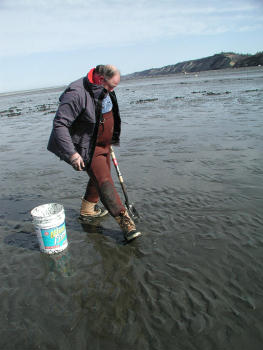 |
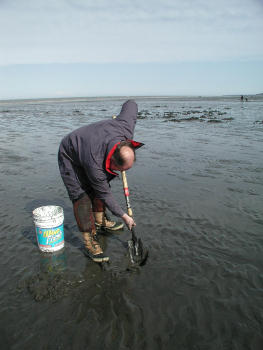 |
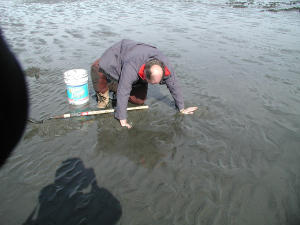 |
Don said he learned a new technique that day of taking little scoops of sand at a time until the neck of the clam was visible - the plunging his hand in the sand and feeling around for the clam. Some of them pulled pretty hard trying to stay in the sand. The main clam found on this beech is razor clams 4" to 6" although some get as big as 8". Limit was 45 clams per day. Also picked up were butter clams, little neck clams and cockles. It is a big beech and there may have been 200 people out that day. The parking area had about 100 cars. |
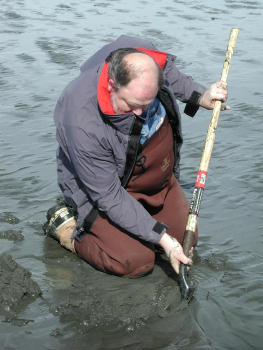 |
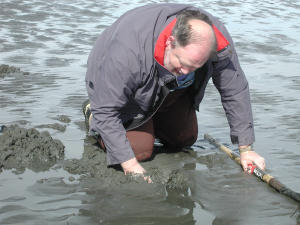 |
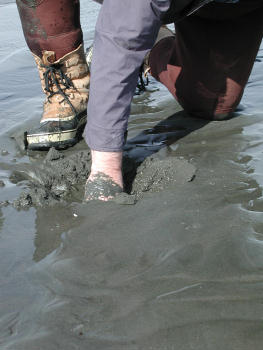 |
|
|
Butter Clam |
Razor Clam |
Situated on the bluffs overlooking scenic Cook Inlet, the recreation area offers visitors a panoramic view of the Aleutian Mountain Range and its three tallest peaks - Mount Iliamna, Mount Redoubt and Mount Spurr.
Wildlife in the area includes moose, bald eagles, gulls and many small birds and mammals. A wide variety of wild flowers may also be found within the recreation area, including the lupine, Jacob's ladder, wild geranium and the prickly rose.
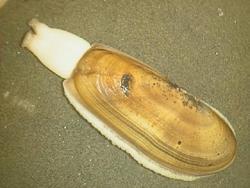 About
Razor Clams
About
Razor Clams
The razor clam, a filter feeder that relies on plankton for food, is found on
sandy tidal beaches from the Bering Sea to Southern California. However, there
are only eight known major concentrations of clams on the Pacific Coast, with
four of those inAlaska. The beaches from Clam Gulch to Ninilchik are the most
popular razor clam beaches in the state.
The life cycle of razor clams is simple and unique. Razor clams usually reproduce first at age four or five and live about 14 to 18 years. Reproduction is triggered when Cook Inlet waters reach a temperature of about 55 degrees F, usually between late July and early August. Eggs and sperm are released simultaneously into the surf, where fertilization occurs randomly. Although this method of reproduction is not very efficient, the female clam compensates by releasing an estimated five to fifteen million eggs.
After floating in the larval stage for four to six weeks, the clams form a small shell and settle into the sandy tidal beach. The clams are ready for harvest in about four years.
| Fried Clams |
clams (15)
3 eggs
1 cup of flour
1 cup of cracker crumbs
Salt and pepper to taste
Rinse clams, drain, dip in flour, egg, and roll in cracker crumbs. Using high heat, fry in 1/4 inch oil in pan. Brown quickly for one minute or until brown per side. Take out and lay out on paper towels to absorb any grease the serve.
| Razor Clam Fritters |
1 C. chopped razor clams (reserve the liquid)
1 bottle flat beer
1 1/2 C. pancake mix
6 green onions - cut very thin, use greens
1/2 green pepper - cut very thin
1 stalk celery - cut very thin
Mix onions, celery, green pepper and pancake mix together. Add clams and juice to other ingredients, then add beer till you have a very thick mixture that can be dropped from spoon into hot oil at 375 . You may not need all the beer because of the clam juice. Drop by spoonful in oil - cook 2 min. per side - test, if not cooked- drop by smaller spoonfuls.
Digging Clams
Clams may be dug during any low tide, but a tide of minus two feet or lower
is recommended for best results. Consult a tide book for times of minus tides.
To locate razor clams look for small round dimples or holes on the surface of the sand. Once a dimple has been located use a clam shovel to dig a small hole about six inches from the dimple and search through the sand until you find the clam. Be careful when handling the clams as they are "razor" sharp. State law requires that all clams dug be kept regardless of size and condition. Anyone 16 years or older must have a valid Alaska sport fishing license to dig clams.
So you've dug up a bucket of razor clams. What do you do next?
Clean them.
By filtering the water through their systems, the clams rid themselves of sand and grit. (Don't use fresh water; it will kill the clams, which should remain alive until you're ready to clean them.)
Some people submerge them in boiling water instead of pouring the water over them, but this can make them tough.
Here's how to clean razor clams.
As for cooking, that's a delicious cinch. First,dip the clams in an egg wash, then coat them with a prepared seasoned flour.
Next, fry them ever so briefly - two minutes at most - in pre-heated canola oil, until they're golden.
Tender, delicately flavored clams are the reward.
CLAM GULCH, Kenai Peninsula, Alaska
Tide Predictions (High and Low Waters) APRIL, 2002
YEAR MO DA TIME HT. TIME HT. TIME HT. TIME HT.
HHMM FEET HHMM FEET HHMM FEET HHMM FEET
Daylight Savings Time Begins 2:00am 4/07/02
2002/04/24 WE 0207 19.1 0835 0.8 1421 19.4 2053 -1.1
2002/04/25 TH 0251 21.0 0921 -1.7 1515 20.8 2137 -1.7
2002/04/26 FR 0332 22.6 1006 -3.6 1605 21.7 2220 -1.7
2002/04/27 SA 0412 23.5 1049 -4.7 1652 22.1 2302 -1.1
2002/04/28 SU 0452 23.8 1133 -5.0 1738 21.7 2345 -0.0
2002/04/29 MO 0532 23.3 1217 -4.4 1823 20.7
2002/04/30 TU 0029 1.5 0612 22.1 1302 -3.0 1910 19.2
Off-Road Vehicle Use
![]() All off-road-vehicles
are restricted to the campground loop road, the beach access road and the saltwater
beach. Please observe all traffic rules.
All off-road-vehicles
are restricted to the campground loop road, the beach access road and the saltwater
beach. Please observe all traffic rules.
![]() Use of ATVs in
the campground and on the road to the beach is limited to direct travel from
your campsite to the beach and back again.
Use of ATVs in
the campground and on the road to the beach is limited to direct travel from
your campsite to the beach and back again.
![]() ATVs are prohibited
on Clam Gulch Road from the Sterling Highway to the intersection of the campground
loop road and the beach access road.
ATVs are prohibited
on Clam Gulch Road from the Sterling Highway to the intersection of the campground
loop road and the beach access road.
![]() The speed limit
on all recreation area roads is five miles per hour.
The speed limit
on all recreation area roads is five miles per hour.
![]() All drivers and
passengers under age 18 must wear helmets.
All drivers and
passengers under age 18 must wear helmets.
![]() Children under
age 14 must be directly supervised by a parent or other person over age 21,
when driving ATVs.
Children under
age 14 must be directly supervised by a parent or other person over age 21,
when driving ATVs.
Park Rules
Park rules allow all visitors to enjoy our state parks and protect them for
future generations.
![]() Please pay your
camping fee immediately after selecting a site.
Please pay your
camping fee immediately after selecting a site.
![]() Camping stays
are limited to 15 days.
Camping stays
are limited to 15 days.
![]() There is a day
use parking fee.
There is a day
use parking fee.
![]() Fires are permitted
only in fire grates provided or on the saltwater beach.
Fires are permitted
only in fire grates provided or on the saltwater beach.
![]() Please do not
cut live trees or shrubs; collect only dead and down wood.
Please do not
cut live trees or shrubs; collect only dead and down wood.
![]() Motor vehicles
are restricted to roads, parking areas or saltwater beaches.
Motor vehicles
are restricted to roads, parking areas or saltwater beaches.
![]() Pets must be
leashed and under control at all times in developed areas.
Pets must be
leashed and under control at all times in developed areas.
![]() Please do not
litter; use the dumpsters provided.
Please do not
litter; use the dumpsters provided.
![]() Discharge of
firearms and fireworks is prohibited in the recreation area.
Discharge of
firearms and fireworks is prohibited in the recreation area.
![]() Please respect
the rights of those who own private property near the recreation area.
Please respect
the rights of those who own private property near the recreation area.
![]() Quiet hours are
11 p.m. to 6 a.m.
Quiet hours are
11 p.m. to 6 a.m.
Click here to see a map of Clam Gulch State Recreation Area.
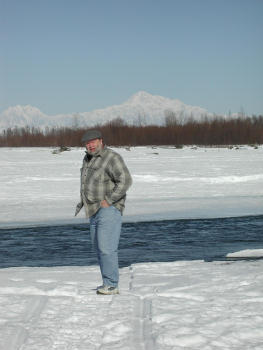 |
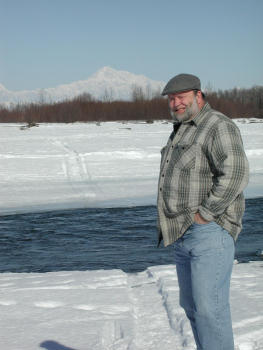 |
Donald Eubank in front of Mt McKinley or its sister mountain at the river at Talkeetna Alaska.
Dr. Will R. Eubank Home Page | Donald A. Eubank Home Page
| Secure Index Page | |
|
| |
|
 Letters Between Relatives
Letters Between Relatives |
Updated: May 17, 2000